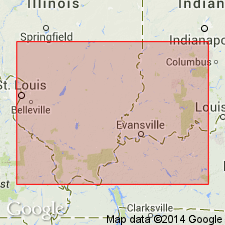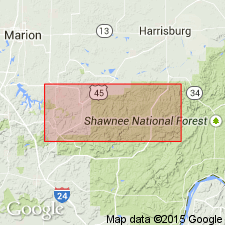
- Usage in publication:
-
- Cora Member
- Modifications:
-
- Named
- Dominant lithology:
-
- Shale
- Limestone
- AAPG geologic province:
-
- Illinois basin
Summary:
Name formally proposed in this report for lower member of Clore Formation of Elviran age. Commonly 15 to 45 ft thick. Type section consists of 12 ft of partly fossiliferous shale containing interbeds about 1 in thick of dark-colored phosphatic sandy limestone overlying a 4-in coal bed at top of Palestine Sandstone and separated form Ford Station Member above by a 22-ft covered interval.
Source: GNU records (USGS DDS-6; Reston GNULEX).

- Usage in publication:
-
- Cora Member
- Modifications:
-
- Overview
- AAPG geologic province:
-
- Illinois basin
Summary:
Clore Formation in the study area is subdivided into (ascending ) Cora, Tygett Sandstone, and Ford Station Members of Swann (1963). Unit can be correlated in outcrop and subsurface throughout southern IL. Well records show that thickness ranges from 95 to 120 ft in the Eddyville and Stonefort quads., and from 110 to 155 ft in the Creal Springs quad. Cora Member (35 to 70 ft thick) consists of shale and thin limestone beds. Age is Chesterian.
Source: GNU records (USGS DDS-6; Reston GNULEX).
For more information, please contact Nancy Stamm, Geologic Names Committee Secretary.
Asterisk (*) indicates published by U.S. Geological Survey authors.
"No current usage" (†) implies that a name has been abandoned or has fallen into disuse. Former usage and, if known, replacement name given in parentheses ( ).
Slash (/) indicates name conflicts with nomenclatural guidelines (CSN, 1933; ACSN, 1961, 1970; NACSN, 1983, 2005, 2021). May be explained within brackets ([ ]).

